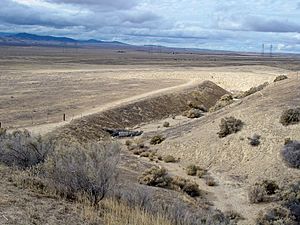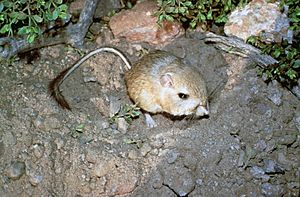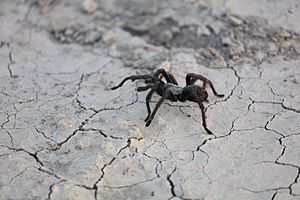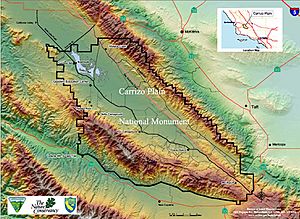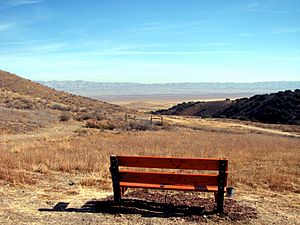Carrizo Plain facts for kids
Quick facts for kids Carrizo Plain National Monument |
|
|---|---|
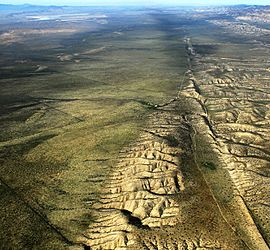
Aerial view of the Carrizo Plain.
The San Andreas Fault is on the right. |
|
| Location | San Luis Obispo & Kern counties, California |
| Nearest city | California Valley, California |
| Area | 246,812 acres (998.81 km2) |
| Established | January 17, 2001 |
| Governing body | Bureau of Land Management |
| Website | Carrizo Plain National Monument |
|
Carrizo Plain Rock Art Discontiguous District
|
|
| Area | 1215 |
| NRHP reference No. | 01000509 |
| Significant dates | |
| Added to NRHP | May 23, 2001 |
| Designated NHLD | March 2, 2012 |
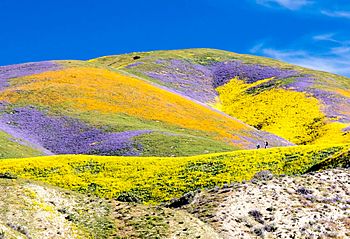
The Carrizo Plain (Obispeño: tšɨłkukunɨtš, "Place of the rabbits"; is a large enclosed grassland plain, approximately 50 miles (80 km) long and up to 15 miles (24 km) across, in southeastern San Luis Obispo County, California, about 100 miles (160 km) northwest of Los Angeles. It contains the 246,812-acre (99,881 ha) Carrizo Plain National Monument, and it is the largest single native grassland remaining in California. It includes Painted Rock in the Carrizo Plain Rock Art Discontiguous District, which is listed on the National Register of Historic Places. In 2012 it was further designated a National Historic Landmark due to its archeological value. The San Andreas Fault occurs along the eastern edge of the Carrizo Plain at the western base of the Temblor Range.
Contents
Geography and geology
The Carrizo Plain extends northwest from the town of Maricopa, following the San Andreas Fault. Bordering the plain to the northeast is the Temblor Range, on the other side of which is California's Central Valley. Bordering the plain to the southwest is the Caliente Range. The community of California Valley is in the northern part of the plain. The average elevation of the plain is about 2,200 feet (670.6 m). Soda Lake, a 3,000-acre (12 km2) alkaline lake, is in the center of the plain with the popular Painted Rock containing Chumash and Yokut rock art nearby. As the central depression in an enclosed basin, Soda Lake receives all of the runoff from both sides of the plain. At 5,106 feet (1,556 m), Caliente Mountain, southwest of the plain, stands as the highest point in San Luis Obispo County. The climate type of the Carrizo Plain is semi-arid grassland. No trees grow there and the annual rainfall is around 9 inches (230 mm) per year.
The Carrizo Plain is an easily accessible place to see surface fractures of the San Andreas Fault; they are clearly visible along the eastern side of the plain, at the foot of the Temblor Range. They are best seen in early morning and evening light, when shadows enhance the topography. In addition to its spring wildflower displays, Carrizo Plain is famous for Painted Rock, a sandstone alcove adorned with pictographs created by the Chumash people around 2000 BC.
Wallace Creek
Wallace Creek is a small stream, draining into Soda Lake, that remains dry most of the year. It drains perpendicular to the San Andreas Fault, and the creek bed is currently offset by 425 ft (130 m) due to the movement of the fault. About 23 ft (7 m) of the displacement was created during the 1857 Fort Tejon earthquake. The current segment began forming 3,700 years ago. Sometime between 1540 and 1630 A.D., the creek was offset by about 40.6 feet (12.4 m) feet in an even larger earthquake.
Two other older creek beds lie 1,560 and 1,310 ft (475 and 399 m) northwest along the San Andreas Fault. The first creek bed was created around 13,000 years ago when climate change formed the creek on a large active alluvial fan. The second bed was created about 11,000 years ago.
The creek has been carefully studied by geologists to find a correlation between the offset and historical events, such as earthquakes, that have occurred along the San Andreas Fault. Although Wallace Creek is not the only creek that has been offset by the San Andreas Fault, it is the most spectacular.
Access
State Route 166 passes the south entrance to the Carrizo Plain, and State Route 58 crosses through the northern portion. Connecting them is the narrow Soda Lake Road, the only dependably passable road through the plain—but even this may become impassable during or soon after a rain since the middle portion of it is gravel.
Geology
San Andreas Fault
The most prominent geologic feature of the Carrizo Plain is the San Andreas Fault, which runs along the northeast side of the plain, at the base of the Elkhorn Scarp. The section of the fault in the Carrizo Plain is the oldest section along the entire fault zone. Displacement on the San Andreas is responsible for the development of distinctive features, including shutter ridges, diverted or decapitated stream channels, and sag ponds.
Other faults
The Big Spring Fault, the San Juan Fault, the Morales Fault, and the White Rock Fault are small faults that run parallel to the San Andreas Fault along the Caliente Range on the western boundary of the Carrizo Plain.
Soil taxonomy
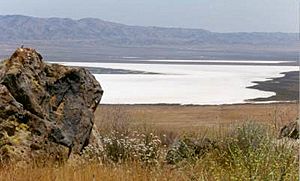
The parent materials for soils in the Carrizo Plain are predominantly alluvium deposits. Alluvium is soil that has been deposited by rivers or flowing water. The Paso Robles formation is a Pleistocene aged alluvium deposit that reaches up to 3,000 ft (900 m) thick near the San Andreas fault and thins out towards the north and west. The Paso Robles formation is a well known aquifer that has been reliably productive for ground wells throughout the area. The upper layers of soil are more recent alluvium. This recent layer is thickest near Soda Lake and thins out towards the mountains to the east and west. Throughout the valley the soil composition varies greatly and includes clay loams, silty clay loams, loams, sandy loams, and gravelly loams. The sandier soils tend to reside near the slopes of the valley and provide greater drainage while the soils with more clay are located on the valley floor near Soda Lake, and have much poorer drainage. The soils in the Carrizo Plain have very low fertility because of their high alkalinity content and low rainfall due to the semi-arid climate.
Fauna
The Carrizo Plain is home to 13 species listed as endangered either by the state or federal government, the largest concentration of endangered species in California. Some of these species include the San Joaquin kit fox, the San Joaquin antelope squirrel, the blunt-nosed leopard lizard, the giant kangaroo rat, greater and lesser sandhill cranes, and the California condor. The tule elk, pronghorn, black-tailed jackrabbit, western coyotes, and Le Conte's thrasher all also make their homes in the Carrizo Plain. The hotter climate and ecology of Carrizo Plain allows the Le Conte's thrasher of the Southwestern United States to have a small disjunct range farther north than normal.
- San Joaquin kit fox – a small nocturnal subspecies of the kit fox that was formerly common throughout the San Joaquin Valley but has recently become endangered.
- Blunt-nosed leopard lizard – a small, 3–5 inch gray to brown lizard with large dark spots and cream-colored cross bands. It has a broad, triangular shaped head and is endemic to California. It inhabits the grasslands and alkali flats of the San Joaquin Valley and the surrounding foothills and valleys.
- Giant kangaroo rat – the largest of all kangaroo rats. The giant kangaroo rat is also endemic to California and now only occupies about 2% of its original range, making it critically endangered.
- San Joaquin antelope squirrel – a light tan squirrel with a white belly and a white stripe down its back and sides. Most of its habitat is used for agriculture, making the Carrizo Plain the habitat for most of the remaining population.
Carrizo Plain National Monument
Management—historical overview
In 1988, U.S. Bureau of Land Management (BLM), the California Department of Fish and Game (DFG), and the Nature Conservancy (TNC) partnered together to purchase an 82,000-acre (332 km2) parcel of Carrizo Plain land. This joint effort ensured the protection of the plain. Then in 1996, the Carrizo Plain Management Partners again created a joint initiative called the Carrizo Plain Natural Area (CPNA) Plan. The goal of this plan was to:
- Establish long-term mission and vision statements that reflect the long-term objectives of the CPNA,
- Outline objectives and goals for the life of this plan that will help to achieve the mission,
- Consolidate a descriptive inventory of area resources and outline appropriate public uses of those resources,
- Provide an overview of operations, maintenance and personnel needs to assist in developing annual work plans and budgeting for implementation of plan goals.
On January 12, 2001, president Bill Clinton signed a presidential proclamation establishing the Carrizo Plain as a National Monument. The first monument manager of the new Carrizo Plain National Monument was Marlene Braun (1958–2005); she was succeeded by Johna Hurl. The managerial partners of the CPNA took the responsibility of maintaining this new national monument. Since then, the area of protected land has increased to 250,000 acres (1,012 km2).
Camping
Campgrounds
Camping within Carrizo Plain National Monument is available at two primitive campgrounds – KCL Campground and Selby Campground. These two sites differ markedly.
KCL is located in the southern part of the monument, west and very close to Soda Lake Road. Access from the main road is easy, and the camping area is generally bounded by a wooden fence. The campground has eight picnic tables and firepits, and is frequently occupied by "day use" visitors, although overnight camping is also allowed. Trees about the campground provide shade – some of the only shade in the monument's valley. As this site was previously owned by the Kern County Land Company, there are several outbuildings in a non-maintained state. The corrals may be used by visitors to stable their horses.
Selby is located more to the north and more distant from Soda Lake Road. A good gravel road leads to the campground from Soda Lake Road over a distance of five miles. The road is generally usable in all weather conditions, but does wind and have some moderate grades as it approaches the campground area. This site is much more rugged, located on a man-made cut into the natural terrain, bounded by hills and canyons. Camp tables are covered by shade structures, a permanent and toilet outhouse is available (no water), camping is allowed anywhere upon the large flat areas. Hiking up and into the adjoining Wilderness Study Area provides hearty exercise and impressive views. The nearby Selby Rocks formation offers a view of large granite boulders. (It is not advised to climb the rocks as the loose granite surface is fragile.) A recent addition is a water spigot that provides non-potable water to the campsites.
Primitive camping
Car camping is also an option within certain areas within the monument, primarily in the foothills. Camping is not allowed in the main valley floor. See the CPNM Visitor Resource Map.
Oil drilling
While the Carrizo Plain is dotted with dry holes drilled and abandoned by oil companies in decades past, no commercially viable quantities of petroleum have ever been found on the plain itself. Small quantities of drillable oil have been found south of the Caliente Range, near the Russell Ranch Oil Field, and in the northeast part of the Temblors, abutting the giant McKittrick and Cymric fields. As the plain is adjacent to the super-giant oil fields of Kern County – the Midway-Sunset Oil Field, third largest in the United States, is on the other side of the Temblor Range – the Carrizo Plain has long been considered to have at least a moderate potential for oil development. However, as it is separated from the major oil fields by the San Andreas Fault, and the underlying source rock, the Monterey Formation appears not to have been buried at the right conditions of temperature and pressure, and as the stratigraphy has not favored petroleum entrapment, accumulations of oil in economically recoverable quantities have not been found. Currently, Vintage Production, a subsidiary of Occidental Petroleum, owns the mineral rights to 30,000 of the monument's 250,000 acres (101,000 ha). When oil prices spiked in 2007, Vintage notified the U.S. Bureau of Land Management of its intentions to find out if oil is contained in the Carrizo Plain. The mineral rights owned by Vintage pre-exist the monument's creation by President Bill Clinton in 2001.
Solar power
The remote Carrizo Plain's status as one of the sunniest places in the state was exploited by the solar power industry from 1983 to 1994. This was by far the largest photovoltaic array in the world, with 100,000 of the 1-by-4-foot (0.3 by 1.2 m) photovoltaic arrays producing 5.2 megawatts at its peak. The plant was originally constructed by the Atlantic Richfield oil company (ARCO) in 1983. During the 1979 energy crisis ARCO became a solar energy pioneer, manufacturing the photovoltaic arrays themselves. ARCO first built a 1 megawatt pilot operation, the Lugo plant in Hesperia, California, which is also now closed. The Carrizo Solar Corporation, based in Albuquerque, New Mexico, bought the two facilities from ARCO in 1990, but the price of oil never rose as was predicted, so the solar plant never became competitive with fossil fuel-based energy production. Carrizo Solar sold its electricity to the local utility for between three and four cents a kilowatt-hour, while a minimum price of eight to ten cents a kilowatt-hour would have been necessary in order for Carrizo to make a profit. Another photovoltaic facility was planned for the site by the Chatsworth Utility Power Group; with an output of 100 megawatts, it would have been many times larger than the existing facility, but the facility never got off the drawing board. The Carrizo Solar Company dismantled its 177-acre (0.7 km2) facility in the late 1990s, and the used solar panels are still being resold throughout the world.
In October 2007, the Palo Alto company Ausra, doing business as Carrizo Energy, filed an application for a 177 MW (peak) Carrizo Energy Solar Farm (CESF) on 640 acres (2.6 km2) adjacent to the previous ARCO site. Instead of photovoltaic cells (as used by ARCO), however, Ausra will use Fresnel reflectors that concentrate solar energy onto pipes in a receiver elevated above the ground. The concentrated solar energy boils water within a row of specially coated stainless steel pipes in an insulated cavity to produce saturated steam. The steam produced in the receivers is collected in a series of pipes, routed to steam drums, and then to the two turbine generators. Steam used by the steam turbines is condensed into liquid water and then returned to the solar field. Electricity from the steam generators will be used in San Luis Obispo county. Local opposition to some solar farm proposals centers on concerns about height above grade, noise and heat plume.
The solar field would have operated daily from sunrise to sunset. Typical operating hours for the CESF would have been approximately 13 hours per day, or an average of 4,765 hours per year. In November 2009, the project was canceled.
On August 14, 2008, Pacific Gas and Electric Company announced agreements to buy the power from two proposed photovoltaic plants in the Carrizo Plain, Topaz Solar Farm and High Plains Ranch, with a combined peak power of 800 MW. If built, these will be the largest photovoltaic plants in the world.
As of November 2014 Topaz Solar Farm is operational, with peak power of 550 MW.
California Valley Solar Ranch opened in 2013.
Images for kids
See also
 In Spanish: Llanura de Carrizo para niños
In Spanish: Llanura de Carrizo para niños



